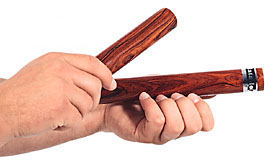"A good drummer listens as much as he plays." ~ Indian Proverb
Percussion Store Drummers Art of Drumming
"A good drummer listens as much as he plays." ~ Indian Proverb
Percussion Store Drummers Art of Drumming
![]()

Drums & Percussion
Latin Percussion
LP Hardware, Accessories & Replacement Parts
African Drums & Accessories
Steel Tongue Drums
Gongs & Tam Tams
Cymbals
Cymbals, Hardware & Accessories
Middle-East Drums & Percussion
Doumbeks, Darbukas & Accessories
Indian Drums & Percussion
Irish Drums & Percussion
Japanese Drums & Skins
White Steer Skins for Taiko Drums
Orchestra Bells & Chimes
Drum & Percussion Hardware
![]()

Clave is a rhythmic pattern which originated in Cuba and Cuban rhythms largely derive from Africa. The Clave is at the heart of West African, Cuban, and Latin music. In essence, the other rhythms and melodies are based around the clave rhythm.
The Clave is not only a rhythm, but is also the name of an instrument, which consists of two, thick sticks. Traditionally, the sticks are made of hardwood, but now there are some synthetic claves on the market. In either case the sticks are hard and make a sharp, clicking-like sound. The picture above shows a pair of claves and the technique for holding them. Notice that one stick rests in one hand while the other stick is held in the other hand and is struck against the stick the rests. Also, notice that in the hand which hold one stick still, there is a slight space between the clave and the palm; this allows the clave to resonate and produce that cutting, clicking sound. So, traditionally, the clave rhythm is played on the claves. However, the clave rhythm can be played on any instruments and it is common to be played on congas, djembes and other hand percussion.
The most common type of clave is called "son clave", named by the Cuban musical style, son (pronounced: sohn).

The above is the 3-2 son clave. The 3 refers to the first bar, which has 3 strokes and the 2 refers to the second bar, which as 2 strokes. In addition, the bars can be reversed so the 2 part is the first bar and the 3 part is in the second bar. In such cases, the rhythm is called the 2-3 clave.
Another type of clave, which is very popular in Salsa is called the rumba clave. Like the son clave, the rumba calve can be a 3-2 or a 2-3. Below is an example of the 3-2 rumba clave (notice how the third note in the first bar is on the "and" of the 4. This change is the only difference between the rumba and son claves).
The 3-2 and 2-3 son and rumba claves are in 4/4 time. In addition, there is also a 6/8 Clave. Below are rhythm charts for all of these claves. There are also video demonstrations of most of these rhythms below.
In addition to the clave patterns the, cowbell rhythm in 6/8 is another quintessential Afro-Cuban rhythm. As the name implies this rhythm is traditionally played on the cowbell, however like the clave it sounds great on most any instrument. You can find the 6/8 cowbell rhythm and the clave rhythms in rhythms charts below. You can also hear the son, rumba & Afro clave rhythms in the videos below.
Key
x = play a stroke
3-2 Son Clave
|
1 |
+ |
2 |
+ |
3 |
+ |
4 |
+ |
1 |
+ |
2 |
+ |
3 |
+ |
4 |
+ |
|
X |
X |
X |
X |
X |
2-3 Son Clave
|
1 |
+ |
2 |
+ |
3 |
+ |
4 |
+ |
1 |
+ |
2 |
+ |
3 |
+ |
4 |
+ |
| X | X | X | X | X |
Video of 2-3 Son Clave
3-2 Rumba Clave (common in Salsa music)
|
1 |
+ |
2 |
+ |
3 |
+ |
4 |
+ |
1 |
+ |
2 |
+ |
3 |
+ |
4 |
+ |
|
X |
X |
|
X |
X |
X |
2-3 Rumba Clave (common in Salsa music)
|
1 |
+ |
2 |
+ |
3 |
+ |
4 |
+ |
1 |
+ |
2 |
+ |
3 |
+ |
4 |
+ |
| X | X | X | X | X |
3 - 2 Son Clave in Touch-tone Form
(clave rhythm used on drums)Clave in 4/4 Played on Congas, Djembe or other hand drums Touch Tones
X = Stroke (such as open or slap)
0 = touch-tone
R = right hand
L = left hand
Note: you can reverse the hand pattern if you prefer
|
1 |
+ |
2 |
+ |
3 |
+ |
4 |
+ |
1 |
+ |
2 |
+ |
3 |
+ |
4 |
+ |
|
X |
0 |
0 |
X |
0 |
0 |
X |
0 |
0 |
0 |
X |
0 |
X |
0 |
0 |
0 |
|
R |
L |
R |
L |
R |
L |
R |
L |
R |
L |
R |
L |
R |
L |
R |
L |
3 - 2 Rumba Clave in Touch-tone Form
(played on congas, djembe and other hand drums)
|
1 |
+ |
2 |
+ |
3 |
+ |
4 |
+ |
1 |
+ |
2 |
+ |
3 |
+ |
4 |
+ |
|
X |
0 |
0
|
X |
0
|
0
|
0
|
X |
0
|
0
|
X |
0 |
X |
0
|
0 |
0
|
|
R |
L |
R |
L |
R |
L |
R |
L |
R |
L |
R |
L |
R |
L |
R |
L |
Clave in 6/8
|
1 |
2 |
3 |
4 |
5 |
6 |
1 |
2 |
3 |
4 |
5 |
6 |
| X | X | X | X | X |
Touch-Tone Form of Clave in 6/8
(played on congas, djembe and other hand drums)
X = stroke (such as open or slap)
0 = touch tone
R = right hand
L = left hand
Note: you can reverse the hand pattern if you prefer
|
1 |
2 |
3 |
4 |
5 |
6 |
1 |
2 |
3 |
4 |
5 |
6 |
| X | 0 | X | 0 | 0 | X | 0 | X | 0 | X | 0 | 0 |
| R | L | R | L | R | L | R | L | R | L | R | L |
Basic Cowbell Rhythm in Six - traditionally played on cowbell, but can be played on any instrument but can be played on any instrument
|
1 |
2 |
3 |
4 |
5 |
6 |
1 |
2 |
3 |
4 |
5 |
6 |
|
X |
|
X |
X |
X |
X |
|
X |
X |
Touch-tone Form Cowbell Rhythm in Six
X = stroke (such as open or slap)
0 = touch tone
R = right hand
L = left hand
Note: you can reverse the hand pattern if you prefer
|
1 |
2 |
3 |
4 |
5 |
6 |
1 |
2 |
3 |
4 |
5 |
6 |
| X | 0 | X | 0 | 0 | X | 0 | X | 0 | X | 0 | 0 |
| R | L | R | L | R | L | R | L | R | L | R | L |
![]()
Instruction
Drums & Percussion